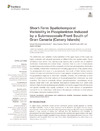Please use this identifier to cite or link to this item:
https://accedacris.ulpgc.es/jspui/handle/10553/106690
| Title: | Short-Term Spatiotemporal Variability in Picoplankton Induced by a Submesoscale Front South of Gran Canaria (Canary Islands) | Authors: | Hernández-Hernández, Nauzet Santana Falcon, Yeray Estrada-Allis, Sheila Arístegui, Javier |
UNESCO Clasification: | 251001 Oceanografía biológica | Keywords: | Canary Islands Frontogenesis Frontolisis Picoplankton Spatiotemporal Variability, et al |
Issue Date: | 2021 | Project: | Estudios de la Bomba Vertical Oceánica en Remolinos de Mesoscala Flujos de Carbono en Un Sistema de Afloramiento Costero (Cabo Blanco, Nw de Africa). Papel Del Carbono Disuelto y en Suspension en El Contexto de la Bomba Biologica. e-IMPACT (PID2019-109084RB-C2) Tropical and South Atlantic - climate-based marine ecosystem prediction for sustainable management |
Journal: | Frontiers in Marine Science | Abstract: | The distribution and variability of phytoplankton in the upper layers of the ocean are highly correlated with physical processes at different time and spatial scales. Model simulations have shown that submesoscale features play a pivotal role on plankton distribution, metabolism and carbon fluxes. However, there is a lack of observational studies that provide evidence for the complexity of short-term phytoplankton distribution and variability inferred from theoretical and modeling approaches. In the present study, the development and decay of a submesoscale front south of Gran Canaria Island is tracked at scales not considered in regular oceanographic samplings in order to analyze the picoplankton response to short-term variability. Likewise, the contribution of each scale of variability to the total variance of the picophytoplankton community has been quantified. We observe statistically different picophytoplankton assemblages across stations closer than 5 km, and between time periods shorter than 24 h, which were related to high physical spatiotemporal variability. Our results suggest that both temporal and spatial variability may equally contribute to the total variance of picoplankton community in the mixed layer, while time is the principal contributor to total variance in the deep chlorophyll maximum (DCM). | URI: | https://accedacris.ulpgc.es/handle/10553/106690 | DOI: | 10.3389/fmars.2021.592703 | Source: | Frontiers in Marine Science [EISSN 2296-7745], v. 8, 592703 (Marzo 2021) |
| Appears in Collections: | Artículos |
SCOPUSTM
Citations
1
checked on Jun 8, 2025
Page view(s)
179
checked on Oct 12, 2024
Download(s)
203
checked on Oct 12, 2024
Google ScholarTM
Check
Altmetric
Share
Export metadata
Items in accedaCRIS are protected by copyright, with all rights reserved, unless otherwise indicated.
